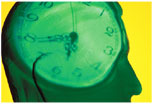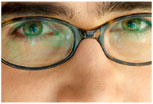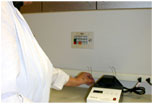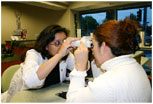Usually, both eyes are affected. One eye starts damage earlier than the other does. If you have an asymmetric appearance of the optic nerves, you may be considered a glaucoma suspect.
Small or conspicuous blood spots over the white of the eye are common. They are harmless and usually clear in a matter of days or weeks.
There is a very slightly increased risk of surgical complications, such as displacement of the IOL, but most people feel that the benefits far outweigh the risk. Today, almost all patients having cataract surgery safely choose an IOL as part of the procedure.
Anesthesia medications can cause stomach upset. The best way to prevent after effects from anesthesia will be to avoid food or drink from midnight the night before surgery.
No. Patients can eat whatever they want.
Cataract surgery cannot be done with a laser by any surgeon at this time. Cataracts are removed surgically by phacoemulsification method. The YAG laser is used only to treat “after cataracts” but not to remove the cataracts.
 Any time a foreign object is placed in the eye; there is an increased risk of problems. Therefore, it is highly recommended that you follow your eye doctor’s instructions about caring and cleaning of your contact lenses and see your eye doctor for regular follow-up exams. Contact your eye doctor, if you experience any problems such as unexplained eye discomfort or pain, redness of the eye, watering eyes, or decrease in vision.
Any time a foreign object is placed in the eye; there is an increased risk of problems. Therefore, it is highly recommended that you follow your eye doctor’s instructions about caring and cleaning of your contact lenses and see your eye doctor for regular follow-up exams. Contact your eye doctor, if you experience any problems such as unexplained eye discomfort or pain, redness of the eye, watering eyes, or decrease in vision.
Most of the time there is no visible scar after the healing is complete. Once healed, the hairline scars will fade.
 Yes. In summary there are four main types of glaucoma:
Yes. In summary there are four main types of glaucoma:
Children should have their first eye exam at about age three. A child’s eyes finish developing by the age of 8-9 years. Always have a child’s vision checked if there is any doubt about how well he or she sees. Early detection of eye problems can sometimes prevent significant damage to the eye or to vision. If any member of your family has eye problems, then it’s best to have your child’s eyes tested at an early age.
 No, lenses should not be worn for longer than the recommended wearing period to stop discomfort, dryness, blurred vision and allergic reactions that can result from a build-up of protein and lipid deposits on the lenses.
No, lenses should not be worn for longer than the recommended wearing period to stop discomfort, dryness, blurred vision and allergic reactions that can result from a build-up of protein and lipid deposits on the lenses.
 Absolutely not. Never wear a lens that is obviously damaged, even if it feels all right. It could be causing damage to your eyes that might not be immediately apparent. In addition, never wear a lens, which is uncomfortable, causing pain or leaves your vision hazy or distorted.
Absolutely not. Never wear a lens that is obviously damaged, even if it feels all right. It could be causing damage to your eyes that might not be immediately apparent. In addition, never wear a lens, which is uncomfortable, causing pain or leaves your vision hazy or distorted.
No, you will not be able to drive yourself. Someone will need to drive you home after your surgery. Someone will need to drive you back to our office for your first postoperative appointment.
No, you should not drive yourself. Someone will need to drive you home after your surgery. Someone will need to drive you back to our office for your first postoperative appointment.
 Generally speaking, you should not swim in your contact lenses. This is for two main reasons. Firstly, it is very easy for the lenses to be washed out of the eye by a small wave or if you place your head under the water. Secondly, the lenses, especially the soft ones, will absorb chlorine or microorganisms from the water. They will then stay in or on the lens for several hours, irritating the eyes and possibly causing infection. Exposure to pool water may also cause contact lenses to adhere quite firmly to you eyes. If this occurs, leave the lenses in the eyes until the natural tears replace the pool water.
Generally speaking, you should not swim in your contact lenses. This is for two main reasons. Firstly, it is very easy for the lenses to be washed out of the eye by a small wave or if you place your head under the water. Secondly, the lenses, especially the soft ones, will absorb chlorine or microorganisms from the water. They will then stay in or on the lens for several hours, irritating the eyes and possibly causing infection. Exposure to pool water may also cause contact lenses to adhere quite firmly to you eyes. If this occurs, leave the lenses in the eyes until the natural tears replace the pool water.
You can get readymade watertight prescription swimming goggles that are safe for swimming. For those involved in active water sports should seriously consider LASIK surgery for vision correction.
 Yes, contact lenses are an excellent option for sports and work out enthusiasts. They may also improve your peripheral vision, depth perception, hand/eye or foot/eye coordination, and increase your overall performance. Unlike glasses, contact lenses are more stable and flexible. They don’t steam up from perspiration, don’t smudge and don’t fog up if you go from cold to warm temperatures. Contacts don’t slide down, or fall off even during vigorous movements. Contact lenses also make it easier for you to wear protective safety goggles.
Yes, contact lenses are an excellent option for sports and work out enthusiasts. They may also improve your peripheral vision, depth perception, hand/eye or foot/eye coordination, and increase your overall performance. Unlike glasses, contact lenses are more stable and flexible. They don’t steam up from perspiration, don’t smudge and don’t fog up if you go from cold to warm temperatures. Contacts don’t slide down, or fall off even during vigorous movements. Contact lenses also make it easier for you to wear protective safety goggles.
 No! Never try to wear contact lenses that were not prescribed to you directly. Even if the lenses are cosmetic or colored lens with no power (plano) you should not share lenses with anyone else. Also, sharing contact lenses can promote the spread of eye disease. Never allow anyone else to wear your lenses.
No! Never try to wear contact lenses that were not prescribed to you directly. Even if the lenses are cosmetic or colored lens with no power (plano) you should not share lenses with anyone else. Also, sharing contact lenses can promote the spread of eye disease. Never allow anyone else to wear your lenses.
Yes, but remember that only extended wear lenses are designed for this purpose.
With the eye guard taped in place, you can sleep on either side. If the guard is off try to sleep on the opposite side.
Absolutely not. Soft lenses will turn into “corn-flakes” and pop when you touch them. Hard lenses should also be stored in a soaking disinfecting solution to reduce lens contamination.
No. Home-made saline is not sterile and there is the risk of bacterial or parasitic contamination. Although extremely rare, the resulting infection can be so damaging that it simply is not worth the risk.
Absolutely not. This can result in infection. Temporary storage in saline is OK, but the lenses will need to be cleaned and conditioned by soaking in an appropriate disinfecting solution prior to use.
The low humidity in airplane cabins causes dry eyes and contact lens discomfort. It may help to put lubrication drops in your eyes before you enter the aircraft or during the flight. If discomfort continues, it is probably easiest to wear eyeglasses when flying.
 No, you cannot use your eyeglass prescription to order your contact lenses. Contact lens prescription and eyeglass prescription are different. It should be noted that the power of a contact lens would not necessarily be the same as that of a spectacle prescription due to the optics of a lens being closer to the eye. A contact lens prescription differs from a spectacle prescription primarily by the addition of lens parameters such as diameter of the lenses, the base curve, the type of material of the contact lens, and the design or manufacturer’s name. If these measurements are not taken by an experienced eye care professional, your contacts may not feel comfortable. Thus, before you can order contacts, you must first undergo a contact lens fitting exam. Doctors charge an additional fee for this fitting exam.
No, you cannot use your eyeglass prescription to order your contact lenses. Contact lens prescription and eyeglass prescription are different. It should be noted that the power of a contact lens would not necessarily be the same as that of a spectacle prescription due to the optics of a lens being closer to the eye. A contact lens prescription differs from a spectacle prescription primarily by the addition of lens parameters such as diameter of the lenses, the base curve, the type of material of the contact lens, and the design or manufacturer’s name. If these measurements are not taken by an experienced eye care professional, your contacts may not feel comfortable. Thus, before you can order contacts, you must first undergo a contact lens fitting exam. Doctors charge an additional fee for this fitting exam.
No, if you have plastic lenses in your glasses then dry tissues will scratch them. It is generally better to dampen the tissue, or even use soapy water and a soft cloth. Glasses with anti-reflective coating should be cleaned with a special cloth and spray.
Yes, but the refractive surgery will have change the curvature of your cornea, requiring a more specialized lens than normal. It is best to consult your eye doctor.
Yes. Try to avoid getting makeup on your lenses. Always insert your lenses before applying eye shadow, eyeliner, and mascara.
Yes. If a child is more than 3 years old, lens implant can be considered. The lens power may not be calculated very precisely in children because of the growing age.
No, the best patients are those who are healthy, psychologically stable and well motivated. Some medical conditions may increase the risk of pterygium surgery. Patients with significant eye problems like glaucoma or dry eyes may not be eligible. Uncontrolled high blood pressure or thyroid disease is also of concern. Through consultation and examination, we can determine if you’re a candidate for this rewarding procedure.
Sometimes, a cataract should be removed even if it doesn’t cause problems with your vision. For example, a cataract should be removed if it prevents examination or treatment of another eye problem, such as age-related macular degeneration or diabetic retinopathy. Under such circumstances, your cataract surgery is a medical necessity.
No, if you follow all prescribed steps for inserting, removing and caring for them. Contact lenses are a safe and effective vision correction device. As a contact lens wearer, you should see your eye doctor on a regular basis to ensure good corneal health.
Generally not. With normal use, contact lenses will stay firmly in position. However, they can come out under certain conditions. High winds can cause the eyes to water and pull the eyelid tight against the eye, increasing the chance of lens loss. A sharp blow to the head may dislodge rigid gas permeable lenses. And rubbing your eye carelessly may result in a lost lens.
No. There is no place for it to go. There is a thin, transparent membrane, called conjunctiva that covers the sclera (white part) and inside of your eyelids is well attached to the sidewalls of the eye socket. This forms a seal which prevents contact lenses (as well as dust and other ‘foreign’ material) passing to the back of the eye.
Yes. This is the most important sign of diabetic retinopathy. In early stages, the bleeding is very minimal, in the form of small aneurysms. These areas may leak. In later stages, the retina loses its blood supply and new blood vessels grow. These new blood vessels are very weak and cause bleeding inside the eye.
Yes. Uncontrolled blood sugar can result in cataract formation.
Yes. If new vessels start growing in the angle (drainage area for the eye fluid), a type of glaucoma called “neovascular glaucoma” develops. This is very difficult to manage.
Yes. Bleeding and then scarring inside the eye results in retinal detachment due to traction.
Yes. End result of uncontrolled diabetic retinopathy is permanent blindness.
As a rule, damage caused by glaucoma cannot be reversed. Treatment often can control it. This makes early diagnosis and treatment important to protect your sight.
Yes, contact lenses provide excellent vision for most sports. However, they should also use polycarbonate sports safety goggles or glasses when participating in sports.
If pterygium is interfering in your field of vision, the procedure may be covered as a “medically necessary” surgery. Before surgery, your ophthalmologist will perform a comprehensive eye examination. Photographs are often required by insurance companies before surgery to determine if the procedure is medically necessary. Final decision is made by your insurance carrier after reviewing your condition. Pingueculum surgery is not covered by insurance unless there is a medical necessity. Patients should check with their insurance carrier about their coverage. As a general rule, insurance does not cover cosmetic surgery.
Yes. Early diagnosis and proper treatment is recommended to restore your vision. A small tear in the retina can be treated by laser or gas (Pneumatic Retinopexy). These procedures are in-office procedures. For larger detachment, a scleral buckle procedure is recommended. This procedure is done in a surgical center.
Yes, even a slight blockage of the vision caused by partial retinal detachment can result in blindness if not treated right away.
Yes, the seg height can be raised either by bringing the nose pads together or by adding a pantoscopic tilt.
Yes. Continue with your drops on the other eye as usual.
Yes. Though contact lenses provide benefits, you should still keep your glasses’ prescription current. There may be days that you don’t want to wear your lenses, or when your glasses are better suited for the situation.
Yes, an eye exam is needed to determine the right contact lens fit for you. Because contact lenses are medical devices, they need to be properly fitted by an eye doctor.
 Yes. The single best way to protect your vision is through regular professional eye examinations. Eye care professionals do more than provide eye exams, they care for the overall health of your eyes. This is especially important for contact lens wearers because the contacts could be causing damage to your eyes without necessarily causing any obvious symptoms. You should see your eye care professional regularly.
Yes. The single best way to protect your vision is through regular professional eye examinations. Eye care professionals do more than provide eye exams, they care for the overall health of your eyes. This is especially important for contact lens wearers because the contacts could be causing damage to your eyes without necessarily causing any obvious symptoms. You should see your eye care professional regularly.
No. They do not need to because the material itself allows oxygen to diffuse through it making water irrelevant.
Only if the detachment is due to a successfully treated medical condition such as toxemia of pregnancy or rare forms of eye inflammation.
 There is evidence that sunlight exposure plays a role in certain eye diseases, such as cataract, macular degeneration, pterygium, and eyelid cancer. It is a good idea to wear sunglasses with protection against ultraviolet light. Patients with or at risk for macular degeneration may also benefit from lenses which block blue wavelengths, such as yellow or amber lenses.
There is evidence that sunlight exposure plays a role in certain eye diseases, such as cataract, macular degeneration, pterygium, and eyelid cancer. It is a good idea to wear sunglasses with protection against ultraviolet light. Patients with or at risk for macular degeneration may also benefit from lenses which block blue wavelengths, such as yellow or amber lenses.
In adults, cataract usually causes blurry vision which is reversible if cataract is surgically removed. Rarely, hypermature cataract can induce glaucoma or inflammation in your eye and urgent cataract removal is recommended. If an infant or newborn child has cataract, it can cause permanent blindness. Cataract surgery is urgent in this situation.
For taking your unique fitting measurements, your physical presence is absolutely necessary. We will need to pre-adjust the frame on your face before ordering your glasses.
Light rays are diverged by minus (concave) lenses and converged by plus (convex) lenses.
Find a repeating pattern, like a tiled floor or some wild wallpaper. Hold the sunglasses a few inches from your face, cover one eye, and move the sunglasses slowly up and down, left and right. Look through one of the lenses. If the lines stay straight, you’re holding quality sunglasses. If lines wiggle or waver, your glasses are not of high optical quality and will distort your vision.
Check the vision of each eye by covering alternate eyes with your hand. If the vision is unclear then try swapping the lenses and then recheck the vision.
Find a reflective surface and hold your sunglasses so that you can see the surface through one lens. Rotate the glasses to see if the glare increases or decreases. If the glare decreases, then you know your sunglasses are polarized. Alternatively, try to see an object below the surface of the water through your sunglasses. If you can see the object clearly under water, your sunglasses are polarized.
Another simple way to check the polarization of a lens is by holding the lens over the top of a lens that you know is polarized. A liquid crystal display (LCD) or digital watch is polarized. Hold the lens over the watch on a horizontal plane and rotate it. If the lens is polarized, you will notice the watch display appears darker as you rotate the lens above it. If the lens is not polarized, there will be no visual difference as you view the watch through the lens.
 Soft lenses will appear as a smooth dish shape when placed on the end of a finger and when the lens is the right way inside. Another test is to add saline, drop by drop to fill the bowl. If the edges begin to curl inwards, it’s the correct way.
Soft lenses will appear as a smooth dish shape when placed on the end of a finger and when the lens is the right way inside. Another test is to add saline, drop by drop to fill the bowl. If the edges begin to curl inwards, it’s the correct way.
If you have diabetes mellitus, your body does not use and store sugar properly. High blood-sugar levels can damage blood vessels in the retina, the nerve layer at the back of the eye that senses light and helps to send images to the brain. The damage to retinal vessels is referred to as diabetic retinopathy.
 If you have diabetes, you are also at risk for other diabetic eye diseases. Studies show that you are twice as likely to get a cataract as a person who does not have the disease. Also, cataracts develop at an earlier age in people with diabetes. Cataracts can usually be treated by surgery. Glaucoma may also become a problem. A person with diabetes is nearly twice as likely to get glaucoma as other adults. And, as with diabetic retinopathy, the longer you have had diabetes, the greater your risk of getting glaucoma. Glaucoma may be treated with medications, laser, or other forms of surgery.
If you have diabetes, you are also at risk for other diabetic eye diseases. Studies show that you are twice as likely to get a cataract as a person who does not have the disease. Also, cataracts develop at an earlier age in people with diabetes. Cataracts can usually be treated by surgery. Glaucoma may also become a problem. A person with diabetes is nearly twice as likely to get glaucoma as other adults. And, as with diabetic retinopathy, the longer you have had diabetes, the greater your risk of getting glaucoma. Glaucoma may be treated with medications, laser, or other forms of surgery.
Not very common. Only 6-8 people out of 10,000 experience retinal detachment. Retinal detachment can occur at any age, but it is more common in midlife and later. It affects more men than women, and Caucasians more than Blacks.
It depends on your prescription, your eye health, visual need, and your lifestyle. Only a comprehensive contact lens examination can determine if your sight can be adequately corrected with contact lenses. If you work in a dusty environment or exposed to bright, windy conditions much of the time, eyeglasses may be safer and more comfortable to wear.
Typical signs that a lens is approaching the end of its life is hazy vision, discomfort, and lens discoloration and deposits. These can lead to allergies and other complications.
Typically, your vision will decline and the eye may become achy. In a matter of hours the vision may be totally foggy. Call your doctor or seek emergency help. The greatest risk is during the first week.
The color choice is up to you. In general, choose colors that complement your hair and skin tones. You can choose one color or several colors to be worn all day, every day or simply for special occasions.
Depending upon your visual needs, you may or may not have all of the following items on your prescription:
In most cases, the most important parts of the prescription are the Base Curve, Diameter and Sphere power.
Cover the other eye to determine if vision is still clear from the eye where you suspect that you have lost the lens. If vision is blurred then more than likely the lens is either dislodged from the cornea or has fallen out of the eye.
 Your iris is colored, but does not affect the color of things you see. Enhancer tints highlight a wearers existing eye color and come in a variety of colors including aqua, blue, green, brown, amber and violet. Opaque tints cover the natural color of the iris, making the eye appear a completely different color (such as blue over a brown iris). The wearer sees through a clear area in the center of the lens while showing the world a different eye color.
Your iris is colored, but does not affect the color of things you see. Enhancer tints highlight a wearers existing eye color and come in a variety of colors including aqua, blue, green, brown, amber and violet. Opaque tints cover the natural color of the iris, making the eye appear a completely different color (such as blue over a brown iris). The wearer sees through a clear area in the center of the lens while showing the world a different eye color.
Bifocal segment height is measured from the bottom of the lens to the margin of the lower eyelid.
Progressive segment height is measured from the bottom of the lens to the center of the pupil.
Because retinal tears and detachments are not visible from the outside of the eye, only a comprehensive eye exam can detect them. Your eye doctor will use a light magnification instrument to view the inside of your eye. Your eye doctor may also use certain types of magnification lenses, a slit lamp or ultrasound to diagnose retinal tears or detachments.
Cataract surgery improves quality of life of people by increasing their independence through improved vision; the ability to drive, work, watch TV, and walk safely.
 In many people, increased pressure inside the eye causes glaucoma. In the front of the eye is a space called the anterior chamber. A clear fluid flows continuously in and out of this space and nourishes nearby tissues. The fluid leaves the anterior chamber at the angle where the cornea and iris meet. When the fluid reaches the angle, it flows through a spongy meshwork, like a drain, and leaves the eye. Open-angle glaucoma gets its name because the angle that allows fluid to drain out of the anterior chamber is open. However, for unknown reasons, the fluid passes too slowly through the meshwork drain. In Angle-closure glaucoma, this drain is narrow or closed. As the fluid builds up, the pressure inside the eye rises. Unless the pressure at the front of the eye is controlled, it can damage the optic nerve and cause vision loss.
In many people, increased pressure inside the eye causes glaucoma. In the front of the eye is a space called the anterior chamber. A clear fluid flows continuously in and out of this space and nourishes nearby tissues. The fluid leaves the anterior chamber at the angle where the cornea and iris meet. When the fluid reaches the angle, it flows through a spongy meshwork, like a drain, and leaves the eye. Open-angle glaucoma gets its name because the angle that allows fluid to drain out of the anterior chamber is open. However, for unknown reasons, the fluid passes too slowly through the meshwork drain. In Angle-closure glaucoma, this drain is narrow or closed. As the fluid builds up, the pressure inside the eye rises. Unless the pressure at the front of the eye is controlled, it can damage the optic nerve and cause vision loss.
 Initially, a full correction of eyeglasses is given. If this cannot improve the vision then strong eye is patched until the vision in weaker eye is improved. If strabismus is not improved, eye muscle surgery is recommended to align both eyes to prevent amblyopia. It is vital to the correction of amblyopia that treatment begins as early as possible. A child’s nervous system continues to develop through infancy and can only be corrected during this sensitive period. Doing nothing and waiting will only cause permanent, irreversible damage.
Initially, a full correction of eyeglasses is given. If this cannot improve the vision then strong eye is patched until the vision in weaker eye is improved. If strabismus is not improved, eye muscle surgery is recommended to align both eyes to prevent amblyopia. It is vital to the correction of amblyopia that treatment begins as early as possible. A child’s nervous system continues to develop through infancy and can only be corrected during this sensitive period. Doing nothing and waiting will only cause permanent, irreversible damage.
 Most people think that they have glaucoma if the pressure in their eye is increased. This is not always true. High pressure puts you at risk for glaucoma. It may not mean that you have the disease. Whether or not you get glaucoma depends on the level of pressure that your optic nerve can tolerate without being damaged. This level is different for each person. Although normal pressure is usually between 12-21 mm Hg, a person might have glaucoma even if the pressure is in this range. That is why an eye examination is very important.
Most people think that they have glaucoma if the pressure in their eye is increased. This is not always true. High pressure puts you at risk for glaucoma. It may not mean that you have the disease. Whether or not you get glaucoma depends on the level of pressure that your optic nerve can tolerate without being damaged. This level is different for each person. Although normal pressure is usually between 12-21 mm Hg, a person might have glaucoma even if the pressure is in this range. That is why an eye examination is very important.
Glaucoma is a disease that results in the damage of optic nerve due to high eye pressure. A person may lose peripheral vision due to nerve damage. This loss of vision is permanent and cannot be regained. In contrast, cataract can cause loss of vision which can be regained by successful cataract surgery. Sometimes, cataract and glaucoma can occur together in the same eye.
Pterygium surgery is usually performed by giving small local anesthesia injection to numb the tissues. Generally there is no pain during surgery. If you are very nervous, you will be given a Valium pill to help you relax. A light intravenous sedation may also be given. Patients are awake during surgery. Patients do not hear or feel anything and are comfortable during surgery. Pterygium surgery is commonly done on an outpatient basis.
This varies according to the cleaning and disinfection routine that you use before storing the lens. For specific details, consult the package insert of your lens care system.
 It depends upon you and the type of lens. People with dry eyes may have greater difficulty adjusting to and wearing contact lenses. Soft contact lenses usually take only several days to a week. On the other hand, hard contact lenses may take several weeks to two months before they can be worn comfortably. At first, contact lens wearers may experience some scratchiness, redness, tearing, sensitivity to light and occasional blurred vision.
It depends upon you and the type of lens. People with dry eyes may have greater difficulty adjusting to and wearing contact lenses. Soft contact lenses usually take only several days to a week. On the other hand, hard contact lenses may take several weeks to two months before they can be worn comfortably. At first, contact lens wearers may experience some scratchiness, redness, tearing, sensitivity to light and occasional blurred vision.
 The length of surgery depends on several factors including the complexity of each person’s pterygium. Usually, surgery takes about half an hour.
The length of surgery depends on several factors including the complexity of each person’s pterygium. Usually, surgery takes about half an hour.
Although it may vary from State to State, normal regulations maintain that you should see your eye care practitioner every year to update your prescription and maintain good eye health.
Use the eye drops for at least a 3-4 weeks in tapering dose as instructed by your eye doctor.
Usually, patients look normal after about two to three weeks of surgery. Some patients heal faster, and others take longer. However, at two weeks you know you are well on the way to recovery.
The recommended life of contact lenses varies depending on the type of lenses, from 1-day, 1-week, 2-weeks, 1-month, and longer. With any contact lens, you should follow the prescribed wear and care instructions that include guidelines for replacement.
All surgeries have some risks. If performed by a competent surgeon, complications are infrequent and minor. The vast majority of these operations go perfectly well with excellent results and happy patients. All patients will experience some bruising and swelling for a few days after the surgery. Any surgery has some risk of bleeding and infection. Dr. Tandon will discuss any possible risks with you before surgery is done, and answer all of your questions. Visual impairment is extremely rare. There may be some temporary sensitivity to bright light or wind and we recommend wearing dark glasses when outside.
Clean your lenses daily either in running warm water or with a special lens cleaner. For drying, use a soft cotton cloth or special eyeglass cleaning cloth. When not in use, always store your glasses in their protective case. Never place them face down on their lenses. Always use both hands while putting on or taking off your glasses.
As soon as you see well enough to be confident, are alert from medication, and you are comfortable in the lighting of the day or night.
Your old glasses may be adequate at first. You won’t harm the eye by wearing old glasses. After a couple of weeks the eye may be ready for testing and preliminary lens replacement. However, if you wait until about 4-6 weeks, refraction will be more stable.
 New techniques have significantly reduced healing times. However, each patient’s healing time varies with the type of procedure performed, medical history and physical health. You can expect to go to your work place after a week.
New techniques have significantly reduced healing times. However, each patient’s healing time varies with the type of procedure performed, medical history and physical health. You can expect to go to your work place after a week.
New techniques have significantly reduced healing times. However, each patient’s healing time varies with the type of procedure performed, medical history and physical health. You can expect to go to your work place within a few days.
If the second eye is appropriate for surgery, as little as two weeks may elapse between surgeries, that is if it’s convenient for you and agreed upon by your surgeon.
Some people will see quite well by the next morning. Even with no problems some people will need several weeks of healing for their vision to return to normal.
Your eyes will be patched closed. After surgery, patients usually spend at least one day resting with their head elevated on a pillow and often apply ice packs to reduce swelling. Some patients report a dull headache and tenderness or discomfort. You may also experience temporary numbness.
Before surgery, your ophthalmologist will perform a comprehensive eye examination. Photographs are often required by insurance companies before surgery to determine if the procedure is medically necessary. The final decision is made by your insurance carrier after reviewing your condition.
Pregnant women with diabetes should get an eye exam in the first trimester because retinopathy can progress quickly during pregnancy.
Schedule a complimentary, no-obligation personal evaluation with your surgeon at NeoVision Eye Center to determine if you are a likely candidate for pterygium surgery. There is absolutely no-fee for this assessment, whether or not you choose to have the procedure done. Call 1-510-431-5511.
 Dilated eye examination can detect if you are a suspect for a retinal detachment. The back of the eye will be examined with a special ophthalmoscope and with a slit lamp (clinical microscope). Sometimes a special type of contact lens with built-in mirrors is placed on the eye so the retina can be closely visualized. The ophthalmoscope shines a very bright light into your eye. The light will be uncomfortable, but it is absolutely necessary for a careful and accurate evaluation. Many young nearsighted people have thin areas in their retina called “Lattice degeneration.” These areas could be the precursor for retinal detachment. A laser strengthening procedure can be considered to prevent retinal detachment.
Dilated eye examination can detect if you are a suspect for a retinal detachment. The back of the eye will be examined with a special ophthalmoscope and with a slit lamp (clinical microscope). Sometimes a special type of contact lens with built-in mirrors is placed on the eye so the retina can be closely visualized. The ophthalmoscope shines a very bright light into your eye. The light will be uncomfortable, but it is absolutely necessary for a careful and accurate evaluation. Many young nearsighted people have thin areas in their retina called “Lattice degeneration.” These areas could be the precursor for retinal detachment. A laser strengthening procedure can be considered to prevent retinal detachment.
 If you have dry AMD, you should have your eyes examined by an ophthalmologist through dilated pupils at least once a year. You should also obtain an Amsler grid from your ophthalmologist to use at home. Also check your vision by reading the newspaper, watching television, and just by looking at people’s faces. If you have wet AMD, it is important not to delay laser surgery if your ophthalmologist advises you to have it. You should protect your macula by wearing sunglasses and taking a special vitamin supplement for the eyes. Contact your ophthalmologist regarding the names of these vitamin supplements.
If you have dry AMD, you should have your eyes examined by an ophthalmologist through dilated pupils at least once a year. You should also obtain an Amsler grid from your ophthalmologist to use at home. Also check your vision by reading the newspaper, watching television, and just by looking at people’s faces. If you have wet AMD, it is important not to delay laser surgery if your ophthalmologist advises you to have it. You should protect your macula by wearing sunglasses and taking a special vitamin supplement for the eyes. Contact your ophthalmologist regarding the names of these vitamin supplements.
You should consider using progressive or trifocal lenses.
 Yes. Sometimes people experience discomfort during the peak of their seasonal allergies. If that happens to you, visit your eye doctor. Your doctor may suggest that you simply reduce your wearing time or discontinue wearing your lenses until the allergy symptoms have disappeared. Thoroughly and frequently cleaning your lenses may help reduce allergy discomfort. In addition, never use eye drops that are not made for contact lens wearers when you are wearing your contact lenses.
Yes. Sometimes people experience discomfort during the peak of their seasonal allergies. If that happens to you, visit your eye doctor. Your doctor may suggest that you simply reduce your wearing time or discontinue wearing your lenses until the allergy symptoms have disappeared. Thoroughly and frequently cleaning your lenses may help reduce allergy discomfort. In addition, never use eye drops that are not made for contact lens wearers when you are wearing your contact lenses.
Possibly yes. Now, there are many new types of soft contact lenses available. Many eye conditions, which were previously corrected only by hard contact lenses, may now be corrected with soft contact lenses. Make an appointment with your eye doctor and get trial samples of soft contact lenses.
 There are many kinds of contact lenses available now which will correct astigmatism, both in soft and gas permeable materials. There is a special type of soft lens called a “Toric” lens, which is designed with different curvatures on the front and back to compensate for the astigmatism. They are more difficult to fit and a lot more difficult to manufacture, therefore tend to be more expensive than standard soft lenses but are widely available now, you can even get monthly disposable toric lenses.
There are many kinds of contact lenses available now which will correct astigmatism, both in soft and gas permeable materials. There is a special type of soft lens called a “Toric” lens, which is designed with different curvatures on the front and back to compensate for the astigmatism. They are more difficult to fit and a lot more difficult to manufacture, therefore tend to be more expensive than standard soft lenses but are widely available now, you can even get monthly disposable toric lenses.
You are less likely to be comfortable with contact lenses than someone who has normal eye lubrication. However, you may choose to wear your lenses only occasionally. You can increase the comfort of your lenses by putting eye lubrication drops.
 Your bifocal power needs to be adjusted. Schedule an eye exam with your eye doctor.
Your bifocal power needs to be adjusted. Schedule an eye exam with your eye doctor.
Ask your optician to raise bifocal height or consider using progressive lenses.
It could be your long fingernails or you are closing the case on the contacts. Use a thicker lens.
It all depends upon your reading prescription and how much you care about the quality of your reading vision. If your prescription is SAME for both the eyes and there is NO astigmatism, you can use reading glasses off the shelf. Of course, you will be very limited in choice of frame and you will also compromise on the optical quality of lenses.
If you need to be examined for glasses, it is important that your blood sugar be in consistent control for several days when you see your ophthalmologist. Glasses that work well when the blood sugar is out of control will not work well when sugar is stable. Rapid changes in blood sugar can cause fluctuating vision in both eyes even if retinopathy is not present.
 Lenses with anti-reflective coating. These lenses cut down glare on glasses and improve appearance of your eyes.
Lenses with anti-reflective coating. These lenses cut down glare on glasses and improve appearance of your eyes.
Schedule an appointment at NeoVision Eye Center by calling 1-510-431-5511.
Schedule an appointment at NeoVision Eye Center by calling today at:1-510-431-5511.
Schedule an appointment at NeoVision Eye Center by calling today at 1-510-431-5511.
Schedule an appointment at NeoVision Eye Center by calling us at 1-510-431-5511.
Schedule an appointment at NeoVision Eye Center by calling today at 1-510-431-5511.
Schedule an appointment at NeoVision Eye Center by calling us today at 1-510-431-5511.
Schedule an appointment at NeoVision Eye Center by calling today at: 1-510-431-5511.
You have three options: (1) wear bifocal contacts in both eyes; (2) wear one contact for distance vision, and one for near vision, this option is called monovision; or (3) wear your distance correction in the contacts, and wear reading glasses when needed.
Lenses with ultraviolet coating or Transitions lenses
Schedule a pre-op appointment with your surgeon at NeoVision Eye Center. In keeping with our efforts to maintain the highest standards of patient safety and in an ongoing effort to avoid possible complications, we ask that each of our cataract patients undergo an extensive and comprehensive eye exam by an ophthalmologist prior to surgery. During your pre-op visit, your health history will be reviewed, all your questions will be answered, you will be instructed on how to prepare for surgery, you will be given the prescriptions for use after surgery and we will tell you what to expect. If you are on blood thinners, you will be asked to stop them approximately one week prior to surgery. You will be asked to sign an informed consent.
Schedule a pre-op appointment with your surgeon at NeoVision Eye Center. In keeping with our efforts to maintain the highest standards of patient safety and in an ongoing effort to avoid possible complications, we ask that each of our pterygium patients undergo an extensive and comprehensive eye exam by an ophthalmologist prior to surgery. During your pre-op visit, your health history will be reviewed, all your questions will be answered, you will be instructed on how to prepare for surgery, you will be given the prescriptions for use after surgery and we will tell you what to expect. If you are on blood thinners, you will be asked to stop them approximately two weeks prior to surgery. You will be asked to sign an informed consent. Full fee for the pterygium surgery is due at the time of your pre-op visit.
No, the 2 weeks refers to the actual time of wearing, so they can last longer than 2 weeks if you are not wearing them full time.
Detachment is more likely to occur if the other eye has the condition (such as lattice degeneration) associated with retinal detachment in the first eye. If only one eye suffers a serious injury or requires eye surgery then, of course, the chance of detachment in the other eye is not increased by the event.
Yes, you are at a higher risk of developing glaucoma. Glaucoma can be treated effectively if it is diagnosed in time, so be sure to have a regular eye examination by an ophthalmologist.
No. Retinal holes, breaks, or tears can occur after uncomplicated eye surgery performed at the highest level of excellence.
Many people underestimate the importance of backup pair of glasses. Under certain situations, it may not be possible to repair or replace glasses within the time you have. Imagine, you are about to leave for a business/pleasure trip or you are already on such a trip and your current glasses break. You will unnecessarily go through a lot of inconvenience and lose precious time. You can also imagine what will happen if a student breaks or misplaces his glasses during the exam period. Always keep an extra pair of glasses for unforeseen emergencies. It is like driving a car with a spare tire.
Yes, the eye is healing and may feel irritated at times. This experience usually clears in 1-3 weeks. Lubrication with artificial tears may help and excessive dryness may be present at first.
Yes. It should be noted that a significant number of men and women of all ages elect to have pterygium surgery.
A cataract once removed, cannot grow back. However, during cataract surgery the “posterior capsule”, a very thin, clear membrane that wraps around the backside of the cataract is left intact, and eventually this becomes cloudy. This so called “after cataract” can be treated with a YAG laser. This is a painless office procedure, which restores vision in a matter of minutes to patients with “after cataracts”.
Surgery is the only way to remove a pterygium, but the results can be disappointing. Even with modern techniques, the recurrence rate is often as high as 30 to 40 percent and they tend to come back bigger and faster.
Initial treatment is oriented towards the lowering of eye pressure. First, different types of eye drops are tried. If medicine is not sufficient then laser treatment is considered. The area to be treated is different in OAG versus NAG. When laser does not work then surgery is recommended to open a drainage system in the eye.
No. There is no medicine, eye drop, vitamin, herb, or diet that is beneficial to patients with retinal detachment.
No, there is none. A tall person may need shorter seg height and a shorter person may need a higher seg height.
Yes, there are two ways of writing a prescription for astigmatism. Some prescriptions are written in (-) cylinder and some are written in (+) cylinder. These prescriptions are equal even though they may not appear so.
Your eye will look very red for about 1-2 weeks after the surgery.
There are different types of lasers used in the management of different eye diseases and disorders. The laser used in the treatment of glaucoma is different from the one used in PRK and LASIK surgery.
Light rays passing through the optical center (OC) of a lens are not refracted. With proper PD measurements, your eyes are centered at the optical center of the lens.
Wear the sunglasses when outdoors for about a week. If you prefer you may wear your own sunglasses. There is no need to wear them indoors or outdoors in dim or overcast light.
It should be discussed between the doctor and the parent as to whether the prescription indicates contacts and whether the child is mature enough to follow instructions properly.
Children with this condition may have to be treated with steroids. Eye inflammations associated with this condition are usually treated with long term steroid eye drops. Cataract and glaucoma at the young age may be the result of this treatment. A routine and thorough eye examination is recommended to diagnose and treat glaucoma and cataract in these children.
Sometimes contact lenses ‘hide’ beneath eyelids. If you wear soft contact lenses, they will tend to center automatically on the cornea. If you wear rigid gas permeable (RGP) lenses, you may need to manipulate a displaced lens through the eyelid. In rare instances, an RGP lens may adhere by suction to the conjunctiva. First, apply wetting solution to the lens and wait about a minute. Then try to move the lens while gently pressing on one edge. If that doesn’t work, you can try to very gently lift up under one edge to break the seal. Or go see your eye doctor. If a contact lens adheres repeatedly, it is not fitted correctly and should be replaced.
Use re-wetting drops.
There are three possibilities (1) tear in contact; (2) increased deposits, or (3) contact is inside out.
It indicates increased deposits on the contacts and/or possible allergic response of upper lids to dirty contacts. Discard the old lenses and use fresh ones.
It is not advisable to wear contact lenses if your eyes are bothering you, particularly if the discomfort is related to contact lens wear.
 Wear photogrey, light tint, Transitions lenses, or polarized lenses.
Wear photogrey, light tint, Transitions lenses, or polarized lenses.
You need frame adjustment. Also, consider lighter lenses such as hi-index or polycarbonate in a smaller frame.
Eyeglasses ordered under an insurance plan are usually processed by the insurance labs and we do not have much control over it. They usually take 5-10 business days. However, if you order your glasses privately (i.e. without an insurance plan) and you need single vision lenses without any special coatings, your glasses can be made ready in 1-2 days.
We usually promise 5-10 business days to process an eyeglass job. The actual time for a particular pair of eyeglasses depends upon a variety of factors including your prescription and lens options you have chosen. Remember, eyeglasses are a custom-product i.e. they are made to your unique specifications. Occasionally, during the process of lens edging and mounting, the frames or the lenses are damaged and the lab needs to start the order all over again. This can add to the overall time to finish a particular job. Eyeglasses with drill mount lenses (i.e. rimless frames) generally take longer.
 At NeoVision, we apply stringent quality control standards on each and every eyeglass order. Our opticians inspect every job after it has already been checked and approved by the manufacturing lab. If we notice any defects in the frame or lenses, we will not deliver it to you. Instead, we reorder the frame or the lenses and process the order all over again. While this could add time to your order, you can be assured that the final product you receive from us will be in a perfect condition. Our emphasis is on the finest quality of the final product rather than rushing an order.
At NeoVision, we apply stringent quality control standards on each and every eyeglass order. Our opticians inspect every job after it has already been checked and approved by the manufacturing lab. If we notice any defects in the frame or lenses, we will not deliver it to you. Instead, we reorder the frame or the lenses and process the order all over again. While this could add time to your order, you can be assured that the final product you receive from us will be in a perfect condition. Our emphasis is on the finest quality of the final product rather than rushing an order.
For the first few hours there may be some discomfort, but usually not severe. If the pain persists, call your doctor.
At NeoVision Eye Center, we believe the fairest approach is to offer cataract surgery for one Flat Fee. That is why we offer one global comprehensive fee, which includes all pre-operative, surgical, and post-operative care. A price estimate will be given at your consultation for cataract surgery. Fees reflect the specific problem that you have and the extent of surgery to correct it
 At NeoVision Eye Center, we believe the fairest approach is to offer pterygium surgery for one Flat Fee. That is why we offer one global comprehensive fee, which includes all pre-operative, surgical, and post-operative care. A price estimate will be given at your consultation for pterygium surgery. Fees reflect the specific problem that you have and the extent of surgery to correct it.
At NeoVision Eye Center, we believe the fairest approach is to offer pterygium surgery for one Flat Fee. That is why we offer one global comprehensive fee, which includes all pre-operative, surgical, and post-operative care. A price estimate will be given at your consultation for pterygium surgery. Fees reflect the specific problem that you have and the extent of surgery to correct it.
You can order your own custom reading glasses by choosing any of our eye glass frames and adding reading lenses in your unique prescription. You will be able to order glasses with clear prescription lenses or with tinted prescription sunglass lenses with anti-scratch, anti-UV, and/or anti-reflective coating. You will also have a choice of lens materials such as CR-39 plastic, polycarbonate, Trivex, or hi-index.
There are two types of macular degeneration. A “dry” type that can cause a decrease in your central vision and a “wet” type that can lead to further loss of your central vision.
An IOL is a permanent replacement for your natural lens. After it has been placed inside your eye during cataract surgery, it requires no further care. You probably won’t be able to feel your new lens; and others will not notice it either. An IOL never needs to be handled, adjusted, or cleaned.
With prompt medical attention, most of the complications usually can be treated successfully. Possible complications that could occur during surgery include the following:
Risk factors for retinal detachment include the following:
 At first, open-angle glaucoma has no symptoms. Vision stays normal, and there is no pain. As glaucoma remains untreated, people may notice that although they see things clearly in front of them, they miss objects to the side and out of the corner of their eye. Without treatment, people with glaucoma may find that they suddenly have no side vision. It may seem as though they are looking through a tunnel. Over time, the remaining forward vision may decrease until there is no vision left. Angle closure glaucoma causes severe and acute eye pain, blurry vision, nausea vomiting etc. Often an emergency laser treatment is given to lower the eye pressure.
At first, open-angle glaucoma has no symptoms. Vision stays normal, and there is no pain. As glaucoma remains untreated, people may notice that although they see things clearly in front of them, they miss objects to the side and out of the corner of their eye. Without treatment, people with glaucoma may find that they suddenly have no side vision. It may seem as though they are looking through a tunnel. Over time, the remaining forward vision may decrease until there is no vision left. Angle closure glaucoma causes severe and acute eye pain, blurry vision, nausea vomiting etc. Often an emergency laser treatment is given to lower the eye pressure.
 A sudden increase in number and size of floaters is a warning that small amounts of blood and debris have appeared in the vitreous. The flashes are sensations from the retina as it is pulled or torn, or is rubbed by the loosened vitreous. If a tear breaks a larger retinal blood vessel, the blood spilling into the vitreous can cause a massive increase in floaters or even total loss of vision in that eye. The floaters will usually decrease in a few weeks or months and vision will improve, as long as the retina is not detached.
A sudden increase in number and size of floaters is a warning that small amounts of blood and debris have appeared in the vitreous. The flashes are sensations from the retina as it is pulled or torn, or is rubbed by the loosened vitreous. If a tear breaks a larger retinal blood vessel, the blood spilling into the vitreous can cause a massive increase in floaters or even total loss of vision in that eye. The floaters will usually decrease in a few weeks or months and vision will improve, as long as the retina is not detached.
Most retinal tears do not cause problems and are not especially dangerous. However, if fluid starts to leak through them, the retina will start to peel (like wallpaper) and the detachment process begins. At first, you may have no symptoms, especially if the detachment is off to the side. Later, a “curtain” of darkness will start moving in and block out vision from one direction (the position depends on the location of the detachment). When the peeling process reaches the central zone of the retina (the macula), vision will suddenly and dramatically blur. As time goes on (which could be hours, days, or weeks), the curtain will continue to darken more and more of your vision, until you are left only able to see bright light. If you experience any of these symptoms, contact your ophthalmologist as soon as possible for a thorough evaluation.
Your ophthalmologist can give you instructions on how to treat amblyopia. Children do not like to have their eyes patched. But as a parent, you must convince your child to do what is best for him or her. Your interest and involvement will be necessary for successful treatment.
 If you are being treated for glaucoma, be sure to take your glaucoma medicine every day and see your ophthalmologist regularly. You can also help protect the vision of family members and friends who may be at high risk for glaucoma. Afro-Americans over age 40 and everyone over age 60 are at a higher risk of glaucoma. Encourage them to have an eye examination through dilated pupils every one-two years.
If you are being treated for glaucoma, be sure to take your glaucoma medicine every day and see your ophthalmologist regularly. You can also help protect the vision of family members and friends who may be at high risk for glaucoma. Afro-Americans over age 40 and everyone over age 60 are at a higher risk of glaucoma. Encourage them to have an eye examination through dilated pupils every one-two years.
Finding and treating the disease early, before it causes vision loss or blindness, is the best way to control diabetic eye disease. Therefore, if you have diabetes, make sure you get a dilated eye examination at least once a year.
A routine follow-up with your ophthalmologist and early and proper treatment is recommended to prevent this blindness. Depending on your initial examination, you may need examination every 3 months to once a year. Along with an eye examination, a good control of your blood sugar is very important.
Normal use of your eyes will not cause further damage to your vision. Even if you have lost sight to AMD, you should not be afraid to use your eyes for reading, watching TV, and other usual activities.
Retinal detachment is caused by a combination of factors including retinal holes, retinal breaks, or retinal tears, and liquefaction of the vitreous humor. Any tiny tears or holes in the retina can allow vitreous fluid to seep under the retina, separating it from the back wall of the eye (like wallpaper). Retinal tears may also result from a hard blow or injury to the eye, though this is rather rare.
There may be other reasons for visual loss in addition to the cataract, particularly problems involving the retina or optic nerve. If these problems are present, removal of the cataract may improve vision, but perfect sight may not be possible.
Your eyeglass prescription contains information regarding the lens power required to correct your vision problems. It consists of spherical power, cylindrical power, cylinder axis, bifocal addition, and prism power. Your prescription will contain only those numbers that are pertinent for your vision correction, for example, if you do not have astigmatism, you would not have a cylindrical power and axis information in your prescription. Most prescriptions do not contain prism power.
Frames are identified by manufacturer/designer, model number or name, size, and color information. Size information contains the horizontal measurement of each lens in millimeters (i.e. 47) and bridge size (the distance between the lenses) i.e. 18. This information can help you in sizing a frame for your face. To better understand the frame size, double the first number and add the second. This will give you the distance across the full front of the frame. For example, a frame size of 47/18 means that the frame measures 112 mm across (47 x 2 + 18 = 112).
Frame size may also contain the temple length (including the portion going behind the ear) in millimeters such as 145. Therefore a frame size would be written 47/18 or 47-18 or 47/18-145. Color may be noted as a description such as gunmetal, other manufacturers use a color number. NeoVision’s opticians will help you in choosing the right size frame for the best possible fit.
The procedure is called surfacing which involves grinding the back side of a lens.
Informed consent means you have an excellent understanding about the benefits of surgery as well as any risks, and all the preoperative and postoperative information. You are making an “informed” decision as to whether surgery is right for you.
Informed consent means you have an excellent understanding about the benefits of surgery as well as any risks, and all the preoperative and postoperative information. You are making an “informed” decision as to whether surgery is right for you.
Retinal detachment can also occur as a complication of diabetic retinopathy, retinopathy of prematurity, inflammatory disorders, or trauma.
It’s normal to feel itching and mild discomfort for a while after cataract surgery. Some fluid discharge is also common, and your eye may be sensitive to light and touch. If you have discomfort, your eye doctor may suggest a pain reliever every 4-6 hours. After 1-2 days, even moderate discomfort should disappear. In most cases, healing will take about 6 weeks.
After surgery, your doctor will schedule exams to check on your progress. For a few days after surgery, you may take eye drops or pills to help healing and control the pressure inside your eye. Ask your doctor how to use your medications, when to take them, and what effects they can have.
Surgery is usually performed on an outpatient basis. The operation usually lasts less than 1 hour and is almost painless. When you arrive for surgery, some eye drops will be instilled to dilate your pupil. Many people choose to stay awake during surgery, while others may need to be put to sleep for a short time. If you are awake, you will have an anesthetic to numb the nerves in and around your eye.
The area around your eye will be thoroughly cleansed, and sterile coverings are placed around your head. Under an operating microscope, a small incision is made in your eye. Microsurgical instruments are used to break apart and suction the cloudy lens from your eye. The back membrane of the lens (called the posterior capsule) is left in place. An intraocular lens implant is placed inside your eye to replace the natural lens that was removed. The incision is then closed. No stitches are used.
After the operation, a patch will be placed over your eye and you will rest for a while. You will be watched by your medical team to see if there are any problems, such as bleeding. Most people who have cataract surgery can go home the same day. Since you will not be able to drive, make sure you make arrangements for a ride.
Cornea has 70-80% of eye’s focusing power.
 If you are wearing daily contact lenses, you should always take them out before you go to sleep. If, however, you do fall asleep with them on your eyes, remove your lenses as soon as you get up, and follow the recommended lens cleaning and disinfecting instructions. It may be helpful to put drops in your eyes before removing your lenses to moisturize them.
If you are wearing daily contact lenses, you should always take them out before you go to sleep. If, however, you do fall asleep with them on your eyes, remove your lenses as soon as you get up, and follow the recommended lens cleaning and disinfecting instructions. It may be helpful to put drops in your eyes before removing your lenses to moisturize them.
If you have pierced ears, the way you healed there is a good indication of how you will heal from pterygium surgery. Scars on the rest of the body typically are not an indication for how patients heal following pterygium surgery. At the time of your consultation, it’s important to show your physician any previous scars (called keloid scars) that are of concern so your doctor can give you a realistic assessment of your healing potential following pterygium surgery. If you have a history of abnormal scarring, there are medications that can be used to help prevent excess scarring.
Bottle rockets, BB guns, racquetball, tennis, golf, soccer, boxing, and diving injuries can lead to retinal detachment.
 UV400 means that the lens blocks all lightwaves 400 nanometers and below. 400 nanometers is typically referred to as the point where UV light starts. Anything below 400 nanometers is considered to be in the ultraviolet range.
UV400 means that the lens blocks all lightwaves 400 nanometers and below. 400 nanometers is typically referred to as the point where UV light starts. Anything below 400 nanometers is considered to be in the ultraviolet range.
A diopter is a unit of measurement that is simply the inverse of the focal distance of the lens as measured in meters. For example, if a lens has a strength of 2 diopters, then parallel light rays that pass through this lens will focus together at a distance of 1/2 meter (50 cm) away from the lens.
A lens with no corrective power is called plano.
 Retinal detachment is a serious condition that can lead to severe visual impairment or even total blindness in the affected eye. If any part of the retina is lifted or pulled from its normal position, it is considered detached, and will cause some vision loss. The detachment will almost always progress, and vision loss will increase until it is treated. Therefore, retinal detachment is always considered an emergency.
Retinal detachment is a serious condition that can lead to severe visual impairment or even total blindness in the affected eye. If any part of the retina is lifted or pulled from its normal position, it is considered detached, and will cause some vision loss. The detachment will almost always progress, and vision loss will increase until it is treated. Therefore, retinal detachment is always considered an emergency.
 Amblyopia is reduced vision in an eye that did not develop normal sight during early childhood. It is sometimes called “lazy eye.” It can be avoided by having children’s eyes examined between the ages of three and five. Amblyopic eye is normal by examination but it cannot see very well. Visual improvement is possible until 9 years of age.
Amblyopia is reduced vision in an eye that did not develop normal sight during early childhood. It is sometimes called “lazy eye.” It can be avoided by having children’s eyes examined between the ages of three and five. Amblyopic eye is normal by examination but it cannot see very well. Visual improvement is possible until 9 years of age.
In most cataract surgeries, the removed lens is replaced by an intraocular lens (IOL). An IOL is a clear, artificial lens that requires no care and becomes a permanent part of your eye. With an IOL, you’ll have improved vision because light will be able to pass through it to the retina. Also, you won’t feel or see the new lens.This IOL can be of different material such as plastic, silicon or acrylic. All of these materials are tested for years and do not cause any problem once they are nicely implanted in your eye.
Some people cannot have an IOL. They may have problems during surgery, or maybe they have another eye disease. For these people, a soft contact lens may be suggested. For others, glasses that provide powerful magnification may be better.
Sometimes the thin natural bag (capsule) that supports the intraocular lens becomes cloudy and may blur your vision. This is called an after-cataract. An after-cataract can develop months or years later. Unlike a cataract, an after-cataract is treated with a laser. In a technique called YAG laser capsulotomy, your doctor uses a laser beam to make a tiny hole in the lens capsule to let light pass through. This is a painless outpatient procedure.
If there is no value under the cylinder heading, then you have a simple prescription. If there is a value under this heading, then you have astigmatism. Like sphere power, the cylinder power is also measured in diopters.
 Inter-pupillary distance (PD) is the distance from the center of the pupil in one eye to the center of the pupil in the other eye. A PD measurement ensures that the center of the lenses line up with the center of your pupil. Before your prescription lenses are cut into the shape of your frame, the pupillary distance needs to be measured. This measurement is then used so that the optical center of each lens can be lined up with your pupils in order to give optimal visual clarity.
Inter-pupillary distance (PD) is the distance from the center of the pupil in one eye to the center of the pupil in the other eye. A PD measurement ensures that the center of the lenses line up with the center of your pupil. Before your prescription lenses are cut into the shape of your frame, the pupillary distance needs to be measured. This measurement is then used so that the optical center of each lens can be lined up with your pupils in order to give optimal visual clarity.
PD measurements for distance and near vision are different, like 62/59, the first number is your distance PD and the second is for your near PD (for reading-only glasses). For people with asymmetric eyes, PD measurement for each eye is done separately (called “monocular PD”), like 30.5/31.5. The first number is for the right eye (O.D.) and the second number is for the left eye (O.S.).
 A complete evaluation of glaucoma involves checking the eye pressure, clinical examination of the optic nerve, photograph if necessary, and baseline peripheral vision test called “visual field examination.” Later onpachymetry and or HRT is also recommended for evaluation and follow-up of glaucoma. If diagnosed early, medicine can be prescribed to treat this disease. The risk factors for glaucoma increase with increasing age, positive family history, myopia, history of diabetes etc.
A complete evaluation of glaucoma involves checking the eye pressure, clinical examination of the optic nerve, photograph if necessary, and baseline peripheral vision test called “visual field examination.” Later onpachymetry and or HRT is also recommended for evaluation and follow-up of glaucoma. If diagnosed early, medicine can be prescribed to treat this disease. The risk factors for glaucoma increase with increasing age, positive family history, myopia, history of diabetes etc.
 Macular degeneration is damage to the central part of the retina called the macula. The macula is a small area of the retina that allows us to see fine details clearly. When the macula doesn’t function correctly, we experience blurriness or distortion in the center of our vision. Macular degeneration affects both distance and close vision, and can make some activities – like threading a needle or reading – difficult or impossible. Macular degeneration is the leading cause of central vision loss among older people.
Macular degeneration is damage to the central part of the retina called the macula. The macula is a small area of the retina that allows us to see fine details clearly. When the macula doesn’t function correctly, we experience blurriness or distortion in the center of our vision. Macular degeneration affects both distance and close vision, and can make some activities – like threading a needle or reading – difficult or impossible. Macular degeneration is the leading cause of central vision loss among older people.
When the two eyes are not properly aligned and looking directly at the same thing, a prism can be ground into the lenses in order to re-align them. This can occur with strabismus or in situations where the eyes are properly aligned but are under a tremendous amount of strain in order to keep them aligned. The value under the ‘prism’ heading of your prescription denotes the strength of the prism.
This is the main part of your prescription. This number denotes the strength of the lens as measured in diopters.
Strabismus is a visual defect in which the eyes are misaligned and point in different directions. One eye may look straight ahead, while the other eye turns inward, outward, upward or downward.
The “standard plastic” lenses are often called “Hard Resin”, “CR-39 plastic”, or just “plastic” lenses. CR-39® is actually a PPG Industries registered trade name for a DADC (diallyl diglycol carbonate) polymer that was introduced in 1941. The “CR” stands for Columbia Resin and CR-39 was the 39th batch or formula made by Columbia Laboratories in Ohio. The “hard resin” or “CR-39 plastic” is a thermoset plastic meaning it cannot be molded or bent when heated. On the other hand, the polycarbonate polymers are thermoplastic which means that the lenses can be formed by melting polycarbonate pellets and injecting them into a mold.
Our highly skilled opticians help you in selecting the right frame to fit your face comfortably. People usually do not know what to look for in a frame and end up choosing frames that are not appropriate for their prescription or their facial features.
NeoVision’s opticians will also help you in selecting the right lens material (CR-39 plastic, polycarbonate, Trivex, hi index), lens design (single vision, bifocal, trifocal, progressive), and lens coatings (scratch resistance, UV protection, anti-reflective, transitions, polarized) to match your lifestyle.
The optician will measure the precise inter-pupillary distance (PD) to ensure accurate placement of lenses in the frame. PD is the distance from the center of the pupil (black circle) in one eye to the center of the pupil in the other eye. For multifocal lenses (progressive, bifocal, or trifocal), an optician must determine the correct position for the line that divides the distance vision lens from the near vision lens. The optician will mark the demo lenses for the correct position of this line. The height from the bottom of the lens up to the correct position of the lens-dividing line is called “seg-height.” In order to determine the correct seg-height, the optician must fit and adjust the eyeglass frames on the wearer’s face. The seg-height is different for every pair of glasses, and can only be determined after the eyeglasses have been fit to your face by an optician. If your eyeglasses are manufactured without the appropriate measurement of PD and seg-height, they may not function properly for you. Never order eyeglasses without trying the frame on, optician fitting the frame on your face, and taking the measurements.
An aspheric lens is flatter than a spherical lens.
The macula is in the center of the retina, the light-sensitive layer of tissue at the back of the eye. As you read, light is focused onto your macula. There, millions of cells change the light into nerve signals that tell the brain what you are seeing. This is called your central vision. With it, you are able to read, drive, and perform other activities that require fine, sharp, straight-ahead vision.
A special cylindrical lens is needed in order to correct astigmatism. Not only does the strength of the cylindrical lens need to be specified, but the lens itself must be rotated into a specific position in order to provide the proper vision correction. The axis represents the amount of rotation of the cylindrical lens in degrees ranging from 1 to 180.
The base is to the prism what the axis is to the cylinder. As you know, a prism is shaped like a triangle. The thicker the triangle at its base, the stronger is the power. Much like the axis specifies the direction of rotation of the cylindrical lens for astigmatism, the prism must also be rotated into a specific position. But the rotation of the prism is simply specified as ‘base in’ or ‘base out’ (where ‘in’ means towards the nose) or ‘base up’ or ‘base down’. Only these four positions exist as opposed to the 180 positions that can be specified for a cylindrical lens. However, orientations between these four positions can be specified by using combinations of horizontal and vertical prisms in the same lens.
 Diabetic retinopathy: This disease is a leading cause of blindness in American adults. It is caused by changes in the blood vessels of the retina. In some people with diabetic retinopathy, retinal blood vessels may swell and leak fluid. In other people, abnormal new blood vessels grow on the surface of the retina. These changes may result in vision loss or blindness.
Diabetic retinopathy: This disease is a leading cause of blindness in American adults. It is caused by changes in the blood vessels of the retina. In some people with diabetic retinopathy, retinal blood vessels may swell and leak fluid. In other people, abnormal new blood vessels grow on the surface of the retina. These changes may result in vision loss or blindness.
Fluctuation in vision. The excess sugar in diabetics can cause this condition. A good control of blood sugar is recommended to minimize this problem.
The optic nerve is a bundle of more than 1 million nerve fibers. It connects the retina, the light-sensitive layer of tissue at the back of the eye, with the brain. A healthy optic nerve is necessary for good vision.
Anisometropia is a condition where there is a significant difference in the refractive errors of the two eyes. If this condition is present in infancy and is undetected or untreated, it often results in the development of lazy eye or amblyopia in the weaker eye. The greater the amount of the difference, the more likely the development of lazy eye will be. A problem can occur when glasses are made for an anisometropic individual. The difference in the powers of the lenses induces a prismatic difference that can cause double vision in off-center areas of the lens, which can be compensated for by the use of slab-off prism.
Anisometropia is a condition where there is a significant difference in the refractive errors of the two eyes. If this condition is present in infancy and is undetected or untreated, it often results in the development of lazy eye or amblyopia in the weaker eye. The greater the amount of the difference, the more likely the development of lazy eye will be.
There is no correct age for obtaining pterygium surgery. If you are in good health without serious eye problems, your age alone should not keep you from having this procedure.
Cataract surgery is a highly successful procedure. Over 95% of patients experience improved vision, unless there is a problem with the cornea, retina, optic nerve or other structures.
Pterygium surgery is very successful. However, the recurrence rate is often as high as 30 to 40 percent and they tend to come back bigger and faster.
 In early stages, an angiogram is done to detect the sites of bleeding and proper and timely laser treatment to clog these sites can prevent further loss of your vision. In later stages, surgery is done to remove the blood.
In early stages, an angiogram is done to detect the sites of bleeding and proper and timely laser treatment to clog these sites can prevent further loss of your vision. In later stages, surgery is done to remove the blood.
Most sight-threatening diabetic problems can be prevented by laser treatment if it is given early enough. It is important to realize however, that laser treatment aims to save the sight you have, not to make it better. The laser, a beam of high intensity light, can be focused with extreme precision. So the blood vessels that are leaking fluid into the retina can be sealed.
We recommend polycarbonate or high-index aspheric lenses. Avoid rimless frames.
We recommend polycarbonate or high-index lenses in a small frame. Avoid rimless frames.
Direct trauma to the eye can lead to retinal breaks, holes, or tears that occur days, weeks, months, or even years after the incident.
Center is the thinnest part of a minus (concave) lens.
Center is the thickest part of a plus (convex) lens.
 Knowing the symptoms of a retinal detachment is your best defense. Also seek immediate eye care if you experience any symptoms as listed above have regular dilated eye exams if you are very nearsighted or if you have a family history of retinal problems be sure to have your eye doctor examine your eye after any serious eye injury always wear safety eyewear during sports and other hazardous activities
Knowing the symptoms of a retinal detachment is your best defense. Also seek immediate eye care if you experience any symptoms as listed above have regular dilated eye exams if you are very nearsighted or if you have a family history of retinal problems be sure to have your eye doctor examine your eye after any serious eye injury always wear safety eyewear during sports and other hazardous activities
Your sight will usually improve within a few days, although complete healing may take several months. It is a good idea to have some help at home if you can, especially if you find it difficult to put your eye drops in. You can do light housework, cooking, walk, and climb stairs.
 Sunglasses are used for three main reasons: health, performance, and fashion. A quality pair of sunglasses should provide all three functions. Lenses should be of high optical clarity and protect your eyes from harmful effects of UV radiations so that you are protected from developing early cataracts or pterygium. By reducing intense bright light as well as glare, sunglasses should keep you safe whether you are driving or participating in active sports. If you have sensitive eyes, you may also want your sunglasses to filter out more light. Your glasses should also protect your eyes against powerful damaging impacts.
Sunglasses are used for three main reasons: health, performance, and fashion. A quality pair of sunglasses should provide all three functions. Lenses should be of high optical clarity and protect your eyes from harmful effects of UV radiations so that you are protected from developing early cataracts or pterygium. By reducing intense bright light as well as glare, sunglasses should keep you safe whether you are driving or participating in active sports. If you have sensitive eyes, you may also want your sunglasses to filter out more light. Your glasses should also protect your eyes against powerful damaging impacts.
Your choice in sunglasses will also be influenced by fashion. Wire frames go well with most outfits but tend to be more fragile than plastic frames. Wrap-around frames with large lenses will protect you from ambient and direct light and glare from every angle. Wraparounds stick to your face and are in fashion with the surfing, skating, and snowboarding enthusiasts. How your sunglasses look, ultimately, depends on your face, square and rectilinear glasses look better on round faces, and square faces are well suited to oval frames. Strong, lightweight composite or metal frames are typically used for brand-name sunglasses. The higher-quality sunglasses generally have tension springs connecting the arms to the face. Brand-name sunglasses with polarized polycarbonate lenses are comfortable to wear and do not distort colors.
There are two primary ways to remove a cataract. Your ophthalmologist can explain the differences and help determine which is best for you:
 Phacoemulsification, or phaco or small incision cataract surgery. This method used today is an advanced method of cataract removal. Your ophthalmologist makes a small self-sealing incision on the side of the cornea (the clear, dome-shaped surface that covers the front of the eye). The doctor then inserts a tiny probe into the eye. This device emits ultrasound vibrations (pulsing at 40,000 cycles per second) that soften and break up the cloudy center of the lens so it can be removed by suction. This leaves the outer membrane of the lens intact and transparent and provides support for other vital eye components. A specially formulated fluid replaces the fragments during the suction process. Combined with the foldable lens implant, and no-stitch surgery, phacoemulsification is an advanced method of cataract surgery.Phacoemulsification requires more costly supplies and support equipment than other techniques. The surgeon must also have advanced training and considerable experience. Advocates find these additional requirements to be well worth the cost and effort.
Phacoemulsification, or phaco or small incision cataract surgery. This method used today is an advanced method of cataract removal. Your ophthalmologist makes a small self-sealing incision on the side of the cornea (the clear, dome-shaped surface that covers the front of the eye). The doctor then inserts a tiny probe into the eye. This device emits ultrasound vibrations (pulsing at 40,000 cycles per second) that soften and break up the cloudy center of the lens so it can be removed by suction. This leaves the outer membrane of the lens intact and transparent and provides support for other vital eye components. A specially formulated fluid replaces the fragments during the suction process. Combined with the foldable lens implant, and no-stitch surgery, phacoemulsification is an advanced method of cataract surgery.Phacoemulsification requires more costly supplies and support equipment than other techniques. The surgeon must also have advanced training and considerable experience. Advocates find these additional requirements to be well worth the cost and effort.A week or two before surgery, your ophthalmologist will measure the curvature of the cornea and the size and shape of the eye. For patients who will receive an IOL, this information helps your doctor to choose the right type of IOL.
Soft contact lenses, especially dailies, are most appropriate for occasional wear.
Polycarbonate lenses in a flexon frame with spring hinges.
We highly recommend polycarbonate lenses that are more impact resistant.
Plus (convex) lenses are used for correcting hyperopia (far-sightedness) and presbyopia (aging eye vision).
Daily-wear contact lenses are designed to be removed each day for cleaning, and should be taken out before you sleep or nap. Extended-wear lenses can be worn continuously for up to seven days before they are removed for cleaning.
You should plan to take it easy and not work out or play sports for a week. Aerobic and other exercise programs are not allowed for at least two weeks to decrease the risks of bleeding, swelling and bruising. More strenuous activities, such as weight-lifting and contact sports, are not allowed for at least two weeks. Absolutely no bending, lifting or straining during the postoperative period as these activities can increase swelling and delay healing.
You should plan to take it easy and not work out or play sports for a week. Aerobic and other exercise programs are not allowed for at least two weeks to decrease the risks of bleeding, swelling and bruising.
Most patients watch TV and listen to radio 1-2 days after surgery. People generally can read and work at the computer 3-4 days later, though the eyes fatigue faster than usual.
Most patients watch TV within 1-2 days after surgery. People generally can read and work at the computer.
You may take a tub bath and wash your hair in the sink any time following the procedure. Hot steamy showers should be avoided because they could prolong swelling. Routine showers at one week are fine.
You may take a tub bath and wash your hair in the sink about one week following the procedure. Hot steamy showers should be avoided because they could prolong swelling. Routine showers at one week are fine.
Generally, you should stay out of contact lenses for at least two weeks after surgery. Get final clearance from your surgeon before using contact lenses.
Patients take their pain medication as needed. You will begin the antibiotic and pain medications when you arrive home from surgery.
Patients take their pain medication as needed. You will begin the antibiotic and swelling medications when you arrive home from surgery or next day after surgery.
 People with diabetes should schedule eye exams at least once a year. More frequent medical eye exams may be necessary after the diagnosis of diabetic retinopathy. You should have your eyes checked promptly if you have visual changes that affect only one eye; last more than a few days; and not associated with a change in your blood sugar.
People with diabetes should schedule eye exams at least once a year. More frequent medical eye exams may be necessary after the diagnosis of diabetic retinopathy. You should have your eyes checked promptly if you have visual changes that affect only one eye; last more than a few days; and not associated with a change in your blood sugar.
If your child shows ANY sign from the list below, you should consider a comprehensive eye exam by an ophthalmologist.
We see all surgery patients one day after the surgery. Further follow-up will depend upon your individual condition and schedule. Dr. Tandon will be available to see you in the office, if necessary. There is no charge for future visits after surgery.
We see all surgery patients one day after the surgery. Further follow-up will depend upon your individual condition and schedule. Dr. Tandon will be available to see you in the office, if necessary. There is no charge for future visits after surgery.
You can quickly return to many everyday activities, but your vision may be blurry. The healing eye needs time to adjust so that it can focus properly with the other eye, especially if the other eye has a cataract. Ask your doctor when you can resume driving.
If you just received an IOL, you may notice that colors are very bright or have a blue tinge. Also, if you’ve been in bright sunlight, everything may be reddish for a few hours. If you see these color tinges, it is because your lens is clear and no longer cloudy. Within a few months after receiving an IOL, these colors should go away. And when you have healed, you will probably need new glasses.
This may be an allergic reaction to deposits on contacts or possibly an eye infection. Set up an appointment with your eye doctor.
Both are equally effective. It is your preference. Generally, people match the color of transition lenses with the color of the frame.
 Contact lenses can be worn by just about everybody to correct just about any eye condition. They can correct near-sightedness and far-sightedness, as well as astigmatism and presbyopia. Contact lenses can even be worn by people who don’t need vision correction, but who simply want to change their eye color. Remember, contact lenses may not be a good choice for you if you have repeated eye infections, suffer from severe allergic reactions, have dry eyes, or are in a dusty environment.
Contact lenses can be worn by just about everybody to correct just about any eye condition. They can correct near-sightedness and far-sightedness, as well as astigmatism and presbyopia. Contact lenses can even be worn by people who don’t need vision correction, but who simply want to change their eye color. Remember, contact lenses may not be a good choice for you if you have repeated eye infections, suffer from severe allergic reactions, have dry eyes, or are in a dusty environment.
If your vision cannot be improved by changing the prescription of eyeglasses and you are limited in doing your daily routine activities such as driving, playing golf, watching television, or reading due to cataract formation, you are a candidate for cataract surgery.
All people, including children, are at risk. People who spend long hours in the sun because of work or recreation, those who have had cataract surgery, individuals who have certain retinal disorders, and those who take certain medications, such as tetracycline, sulfa drugs, birth control pills, diuretics, tranquilizers etc. are at even higher risk.
Anyone with diabetes. The longer someone has diabetes, the more likely he or she is to get diabetic retinopathy. Nearly half of all people with diabetes will develop some degree of diabetic retinopathy during their lifetime.
Dr. Tandon will meet with you, examine you, and discuss all the possible complications, answer all of your questions, and perform the surgery. Dr. Tandon, MD, PhD is a trained eye physician and surgeon from Stanford University. She is a Certified by American Board of Ophthalmology.
 Dr. Tandon will meet with you, examine you, and discuss all the possible complications, answer all of your questions, and perform the surgery. Dr. Tandon, MD, PhD is a trained eye physician and surgeon from Stanford University. She is a Certified by American Board of Ophthalmology.
Dr. Tandon will meet with you, examine you, and discuss all the possible complications, answer all of your questions, and perform the surgery. Dr. Tandon, MD, PhD is a trained eye physician and surgeon from Stanford University. She is a Certified by American Board of Ophthalmology.
Polycarbonate lens material is so tough that you can hit it with a hammer and it won’t shatter. Ordinary polarizing lenses are made out of plastic (CR-39) and are not shatter resistant. In addition, polycarbonate lenses absorb harmful UV radiations.
Most sight loss from diabetic retinopathy can be prevented but it is vital that it is diagnosed early. You may not realize that there is anything wrong with your eyesight, so regular eye checks are extremely important.
Even lenses without correction are medical devices that can cause problems to your eyes. If you have never worn contact lenses, you need to be fitted by an eye doctor and taught how to insert, remove, and disinfect them. If you already wear clear lenses that are available in a tint then you may substitute with a tint without a problem.
Your doctor has a right and a responsibility to put an expiration date on your contact lens prescription, to ensure that you receive regular check-ups to rule out the possibility of long-term complications of contact lens wear that you may be unaware of.
If a child has strabismus and he/she is focusing with one eye, the other eye becomes lazy.
 Children are at a higher risk from the harmful effects of UV since they generally spend more time outside in the sun. Select sunglasses that suit your child’s active lifestyle. The lenses should be impact resistant i.e. made of polycarbonate.
Children are at a higher risk from the harmful effects of UV since they generally spend more time outside in the sun. Select sunglasses that suit your child’s active lifestyle. The lenses should be impact resistant i.e. made of polycarbonate.
 Although most pterygia are harmless and can be left alone safely; they are surgically removed for the following reasons:
Although most pterygia are harmless and can be left alone safely; they are surgically removed for the following reasons:
After any surgical procedure, some discomfort can be expected. All patients are provided with prescriptions for pain medication. Patients have surprisingly little discomfort after most pterygium procedures. Generally over the counter Tylenol is all patients need (together with ice packs) placed over their eyes for 24 hours. An occasional patient will report unmanageable pain after surgery.
Most first time wearers are delighted with the level of comfort that contact lenses provide. Initial contact lens fittings by an eye doctor can minimize any irritation associated with new lenses. After a brief adjustment period, most people report they can no longer feel contact lenses on their eyes.
Yes. Postoperative prescriptions are provided well in advance of surgery day so you arrive home completely prepared. Postoperative prescriptions and over-the-counter medications for cataract patients include the following: an antibiotic drop and an anti-inflammatory drop four times a day. These drops will be tapered off over 3 weeks.
Yes. Postoperative prescriptions are provided well in advance of surgery day so you arrive home completely prepared. Postoperative prescriptions and over-the-counter medications for pterygium patients include the following: Pain medication (usually Vicodin hydrocodone) to minimize any discomfort following surgery and antibiotic ophthalmic ointment (Polysporin bacitracin ophthalmic) to place gently in the operated eye.
Cataract surgery and lens implantation are intended to restore your vision to normal, minimizing your dependence on glasses / contacts. Although many patients are able to function without glasses, most patients will find that they need glasses for near vision (reading and close-up work), distant vision, or both after cataract surgery.
Most of these operations are covered by insurance. If cataract is interfering in your field of vision, the procedure may be covered as a “medically necessary” surgery and some insurance plans will pay for all or part of the surgery. You should check with your insurance carrier about the coverage.
Most of these operations are cosmetic in nature and are not covered by insurance. If pterygium is interfering in your field of vision, the procedure may be covered as a “medically necessary” surgery and some insurance plans will pay for all or part of the surgery. Pinguecula are generally not covered by insurance unless there is a medical reason. Patients should check with their insurance carrier about their coverage.
Glaucoma surgery is different from the cataract surgery. In cataract surgery, when the cloudy lens is replaced by lens implant, the vision usually improves. In glaucoma, the vision is lost due to nerve damage. This damage is permanent. Glaucoma surgery is aimed to prevent further loss of vision. It cannot restore the lost vision. Therefore, early diagnosis is very important to prevent this permanent loss.